Analysis of Triopoly Game with Isoelastic Demand Function and Heterogeneous Players
Abstract
We analyze a triopoly game model with fully heterogeneous players when the demand function is isoelastic. The three players were considered to be bounded rational, adaptive, and naïve. Existing equilibrium points and their locally asymptotic stability conditions are studied. Complexity of the dynamical system is examined by means of numerical simulations, such as period cycles, bifurcation diagrams, strange attractors and sensitive, dependence on initial conditions. This paper extends the result of Tramontana (2010) who considered a heterogeneous duopoly with isoelastic demand function. Comparisons with respect to the heterogeneous triopoly model of Elabbasy et al. (2009) assuming linear demand function are performed.
1. Introduction
Oligopolistic market is a universal market mechanism, in which a trade is controlled by a small number of firms producing the same or homogeneous products. These firms must consider not only the market demand but also the strategies of their competitors. The most classical and widely used oligopoly model was proposed by Cournot in 1838 [1]. The mathematician Augustin Cournot investigated a duopoly case, where two firms were naïve players. In 1959, Theocharis reconsidered the Cournot oligopoly model assuming a linear demand function and constant marginal costs then he pointed out that an oligopoly system with n players would be only neutrally stable for three players and unstable for four and more players [2]. In [3], Puu pointed out that the Theocharis argument was stated under more general conditions 20 years earlier by palander [4]. After that the similar conclusion was shown by Ahmed and Agiza for a isoelastic demand function and, again, constant marginal costs. They demonstrated that with four players the Cournot equilibrium is neutrally stable and with five and higher becomes unstable [5]. However, it is highly unlikely that all the players are naïve. Therefore, different approaches to firm behavior were proposed. Players were not only naïve but also bounded rational and adaptive.
Some authors studied dynamics of the duopoly game with homogenous expectations [6–8]. They demonstrated that dynamics of the Cournot oligopoly games may never converge to equilibrium and in the long-term bounded periodic or chaotic behavior may be observed. In [8], delay is introduced in a bounded rationality duopoly game model. The analysis showed that the delay case increases the domain of stability, and firms using delayed bounded rationality have a higher chance of reaching a Nash equilibrium point. Models with heterogeneous players were studied [9–13]. In [9, 10], Agiza and Elsadany investigated dynamics of a duopoly game with bounded rational and naïve (adaptive) assuming linear inverse demand function and linear cost functions. Zhang et al. [11] evidenced chaotic behavior in a modification of the game by Agiza and Elsadany [9] introducing nonlinear, in particular quadratic, instead of linear cost functions and thus increasing marginal costs. Dubiel-Teleszynski [12] amended the game by Agiza and Elsadany [10] replacing linear with nonlinear cost functions. Nonlinear demand function was introduced into the duopoly game of Agiza and Elsadany [9] by Tramontana [13]. In theory, there are another three kinds of duopoly game model. These are bounded rational, and adaptive players facing nonlinear demand function and linear cost functions, bounded rational and naïve players assuming nonlinear demand function and cost functions and bounded rational, and adaptive players facing nonlinear demand function and cost functions.
In oligopoly model, all players maximize their profits while triopoly game is a oligopoly market with three players. The dynamics of a triopoly game with homogenous players were discussed in [14–18]. But, the same with duopoly game, it is impossible that all players have the same expectations. Recently, models with heterogeneous players were studied in [19, 20]. In these two papers, triopoly with different expectations were used, namely bounded, rational, adaptive, and naïve expectations. The stability of the triopoly game, bifurcation, and chaotic behavior were analyzed. And the difference of the two papers is as follows: one uses linear cost functions; the other applies nonlinear cost functions. We know isoelastic demand function has its advantages. The advantages are that it always results when the consumers maximize utility functions of the Cobb-Douglas type. Then, all the consumers spend constant budget shares on each commodity and they have demand functions of the same type. In this paper, isoelastic demand function is introduced into the triopoly game. And the three players are completely heterogeneous.
This paper is organized as follows. In Section 2, the triopoly game model with isoelastic demand function and fully heterogeneous players is briefly described. The conditions of the existence and local stability of fixed point will be given in Section 3. In Section 4, numerical simulations are used to demonstrate complexity of the system. Finally, the conclusion of the paper is provided in Section 5.
2. Triopoly Game with Isoelastic Demand Function and Heterogeneous Players
3. Equilibrium Points and Local Stability
Proposition 3.1. The boundary equilibrium point E1 of the system (2.9) is asymptotically stable provided that
Proof. The Jacobian matrix at E1 takes the form:
- (1)
|λ1| < 1,
- (2)
r(1) > 0,
- (3)
r(−1) > 0,
- (4)
r(0) < 1.
In fact, condition (4) indicates a Neimark-Sacker bifurcation. Comparing our boundary equilibrium E1 with the boundary equilibrium E1 in model of Elabbasy et al. [19, 20], their boundary equilibrium is a saddle point, but ours is asymptotically stable under conditions (3.5). This is the consequence of isoelastic demand function and difference between our model and the model of Elabbasy et al. [20].
3.1. Local Stability Analysis of the Nash Equilibrium Point
Inequalities (3.21) are very complex. It is too awkward to provide any simplified from. We will give numerical simulations in Section 4.
Under conditions (3.5), E1 is asymptotically stable, which means in the long run firm 1 will drop out of the market so that the triopoly evolves into duopoly. However, it is very interesting that E* will be stable if the parameters satisfy (3.21), since at the Nash equilibrium every firm will stay in the market.
4. Numerical Simulations
Only a few of simple dynamic system can be concluded as the dynamic characters by analytical method, so the numerical analysis is the prime method in the research on the complicated dynamical behaviors of the discrete dynamical system (2.9). In addition, we will explore the difference between heterogeneous triopoly game with linear demand function and isoelastic. We show some numerical results such as period cycles, bifurcation diagrams, phase portraits, strange attractors, and sensitive dependence on initial conditions.
Figure 1 shows that the convergence to the Nash equilibrium is oscillating. That is to say, the output of the firm 1 is in some period above and in others below the equilibrium level. Figures 2–4 show the value of the output of the bounded rational player respecting to time. Figure 2 is periodic of period 2; the periodicity of Figure 3 is 4; Figure 4 becomes chaotic. Theoretically, as β = 0.2 and α > 18.44, the Nash equilibrium point becomes unstable. Period 2 and period 4 bifurcations appear and finally chaotic behaviors occur. Figure 5 also shows this kind of evolution direction. Figures 1–4 and Figure 5 are just two ways to show the evolutionary process of system (2.9). From Figures 1–5, everyone can see that the Nash equilibrium point is locally stable for small value of parameter of different α, which other authors also concluded. Conversely, a high level of the speed of adjustment of the bounded rational player leads the system to instability.
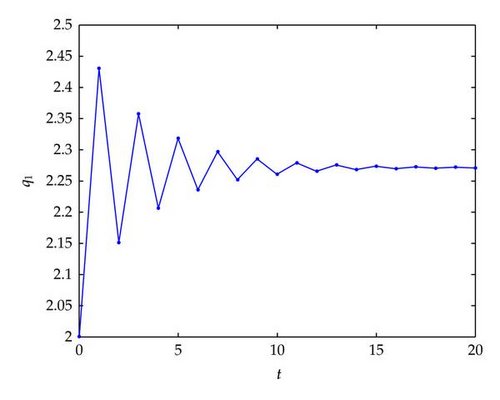
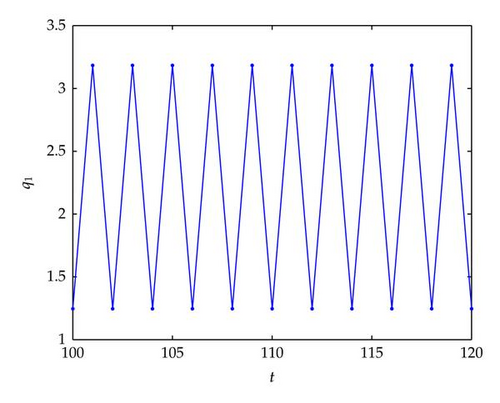
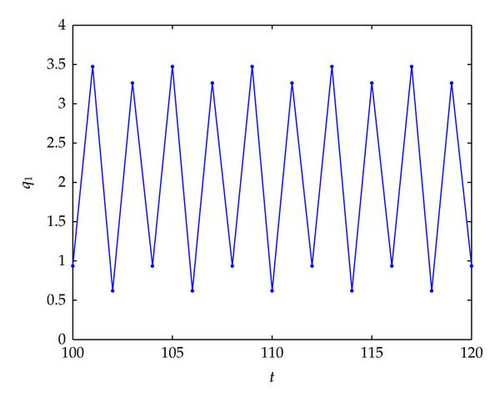

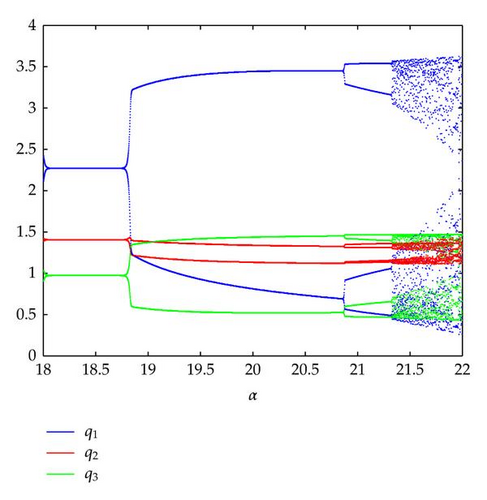
Figures 6, 7 and 8 show the bifurcation diagrams with respect to the parameter β and for different α. From these figures, we can see that system (2.9) transforms from stable to unstable and chaotic eventually when the value of parameter α increases gradually. That is to say, the market will become more and more confused.
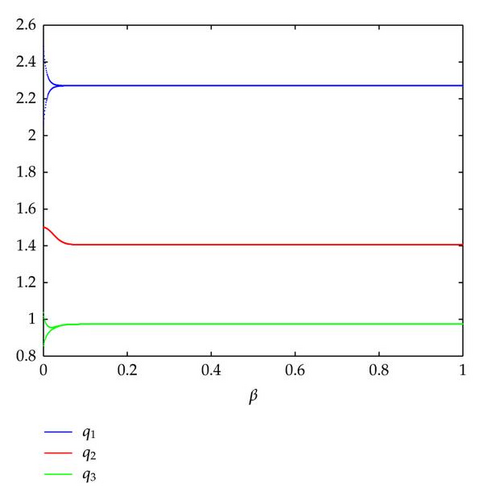
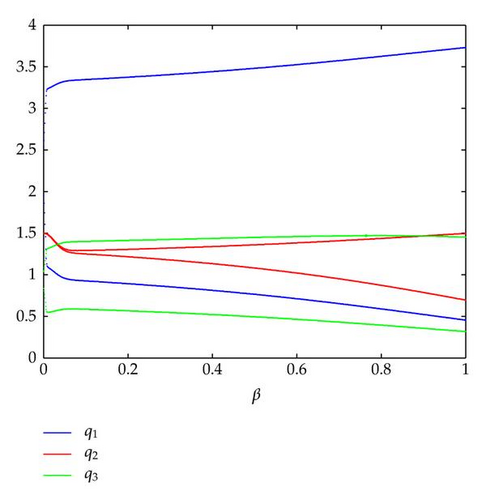
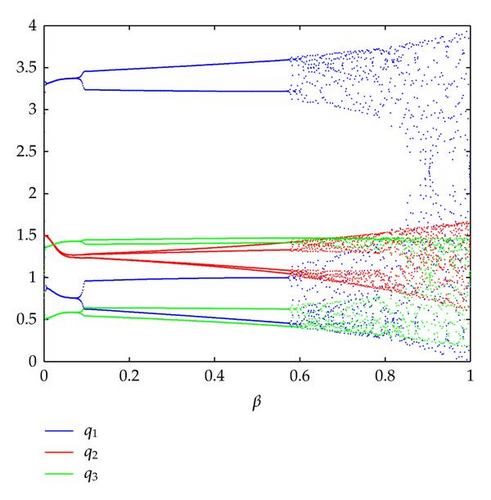
Figures 9, 10, 11 and 12 show the strange attractors for system (2.9). Figures 9–11 show the two-dimension strange attractors. Figure 12 shows the strange attractor from three dimensions.
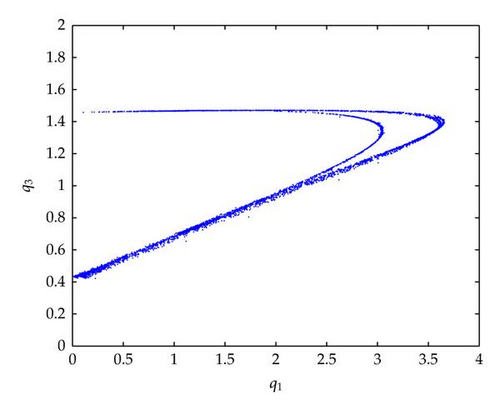
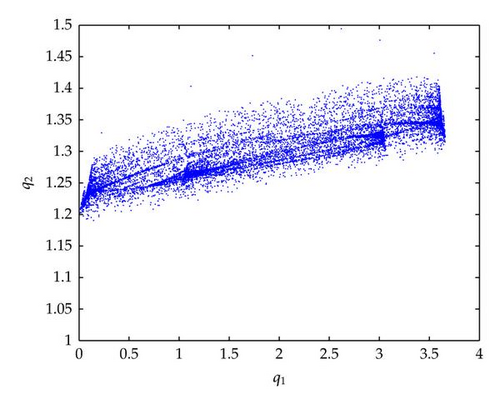

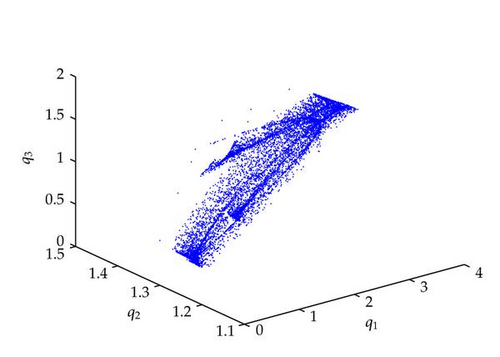
Using (4.1) and conditions (3.21), we get Figure 13 which shows the stability region of the Nash equilibrium point in the plane (α, β). One can see the stability region in this paper is very large compared with respect to the model of Elabbasy et al. [20] and closes to a rectangle region.

From Figures 1–5 and Figure 13, one can deduce that system (2.9) has similar evolutionary process when 0.4 < β < 1.
From Figures 6–8 and Figure 13, one can conclude that the Nash equilibrium point is either stable or unstable. That is to say, the speed of adjustment of adaptive player β has no effect on stability of the market or not. This constitutes a quite relevant difference between our model and the one proposed by Elabbasy et al. [20].
Sensitive dependence on initial conditions is one of the features of chaotic system. In order to demonstrate sensitive dependence on initial conditions of system (2.9), when (c1, c2, c3, α, β) = (0.11,0.15,0.17,23.1,0.2), we simulated two orbits in Figure 14. The red and blue curves start from the initial points (q1(0), q2(0), q3(0)) = (2.0,1.5,1.0) and (q1(0), q2(0), q3(0)) = (2.0001,1.5,1.0), respectively. It shows that, at the beginning, they are indistinguishable, but after a number of iterations, the difference between them builds up rapidly.
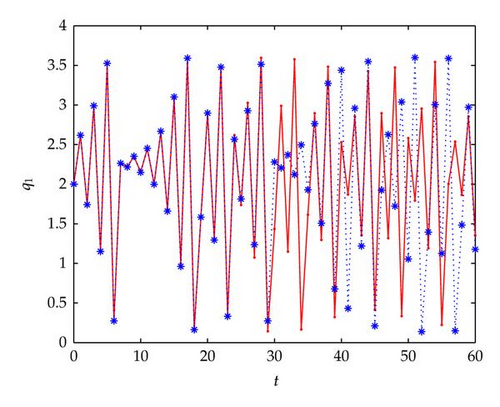
5. Conclusion
In this paper, we propose a fully heterogeneous (bounded rational, adaptive, and naïve expectations) triopoly game model with nonlinear demand function and linear cost functions. The boundary equilibrium point is asymptotically stable under some conditions. The existence condition of the Nash equilibrium point is that the outputs of the three firms must be able to constitute a triangle. Stability region of the Nash equilibrium point is very large compared with respect to heterogeneous triopoly game model with linear demand function and approaches to a rectangle region. The outputs and profits of the firms are not relevant for the decision mechanism the three players adopt in the Nash equilibrium. But the stability of the Nash equilibrium strongly depends on the kind of adjustment adopted. Precisely, it only depends on the speed of adjustment of bounded rational player and is not relevant for the adaptive player.
Acknowledgments
The authors would like to thank the anonymous referees very much for their valuable comments and suggestions. This work was supported by the National Natural Science Foundation of China (no. 70871056) and by the Six Talents Peak Foundation of Jiangsu Province.




